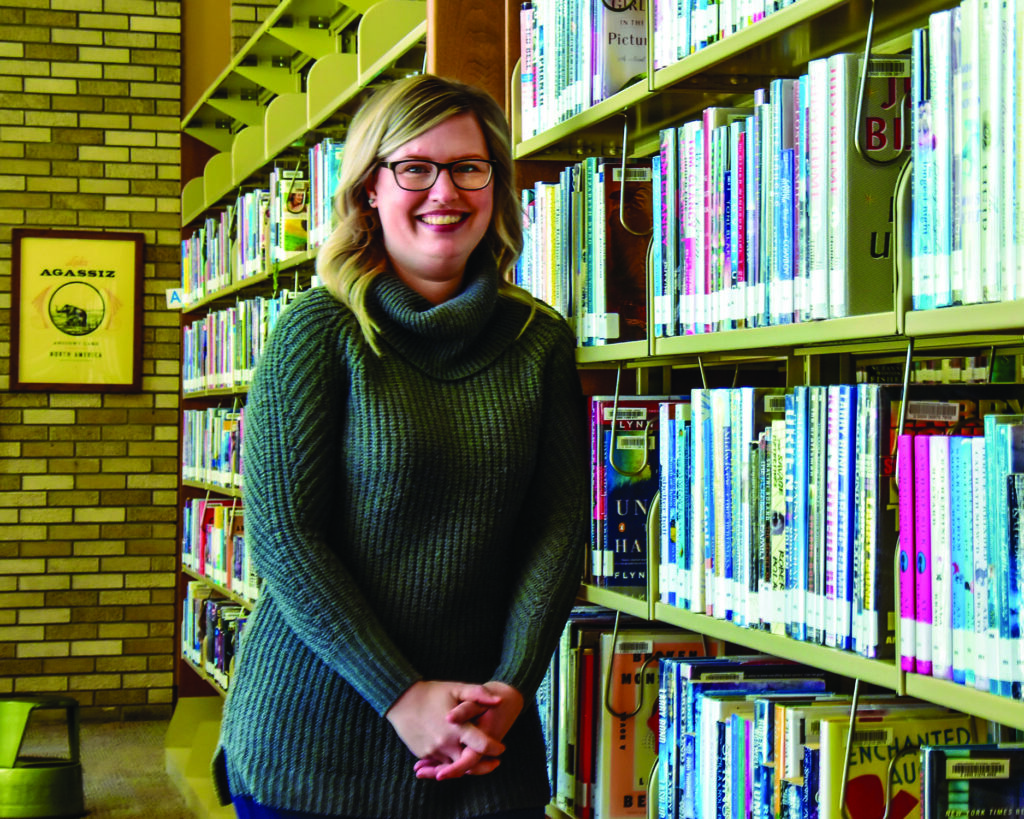
Moorhead Public Library director Megan Krueger is gathering input about what users want to see in a new facility. Photo/Russ Hanson.
Nancy Edmonds Hanson
The librarians of the Moorhead Public Library are in the business of finding answers for their patrons. But now they’re looking to them for answers.
“We want to know more about how people are using the library … and how they would like to use it in the future,” says director Megan Krueger. “We’re in the process of reviewing our space and our patrons’ needs as we look toward our future.”
Somewhere in that future lies a new library to replace the cramped 60-year-old facility at the corner of First Avenue and Sixth Street South. The subject has come up several times in recent years, once as part of the vision for a new city hall, and more recently as a combined library and community center. The subject edged one step closer to reality last month when the Moorhead City Council voted to ask the Legislature to approve a vote on a proposal to enact a city sales tax for that purpose. That permission would be required to take a measure to fund the center’s construction; no decision has been made on whether to float the idea, which would take place no sooner than November 2022.
The shortcomings of the present building, constructed in 1961, are piling up, according to the head librarian: From crumbling exterior walls to an ailing boiler and an HVAC system that needs replacement, and from inadequate meeting spaces to subpar restrooms, the structure did not scored well in an assessment conducted several years ago of city property in urgent need of major improvements.
The library is inviting both users and non-users to comment in a survey expected to begin next week and wrap up in April. An online version is available on the library’s home page; printed copies will also be at the desk and in a variety of sites around town.
The future of the library, Megan says, will be much as it has always been – only with more space for programs already highly popular with the public, from the much-used computer center to children’s programming and meeting spaces for community events.
One thing that definitely will remain and even grow, she asserts, is the rows of shelves for printed books. “Despite what some were predicting five or six years ago, printed books aren’t going away,” she emphasizes. “We have added digital borrowing of books and magazines, but we have found that many, many people continue to prefer print. We are not particularly purchasing fewer books, and our shelves have actually grown a little more crowded.”
The same is true, though, for the digital side of the library. One of the prime attractions that drew 700 to 1,000 visitors a day before the pandemic cut library occupancy and, for a time, locked the doors is the computer center. A steady stream of patrons chooses the library for study or for working purposes. Others come to use its resources to apply for jobs, do their own research, access the internet and print out documents.
The present computer lab has been shoehorned into the area previously used for workspace for the staff of 13. Megan notes that a new location may look somewhat different: “We see more people bringing their own laptops here to use our connections rather than using the desktop systems we provide.”
Coupling a new library with the proposed community center is a natural fit, she points out. “I’d submit that we’re already a community center,” she notes. Shelving has been condensed to accommodate a steady stream of the library’s own events and public programs like the League of Women Voters’ candidate forums.
But the more things may change, the more the library’s central mission remains the same. “Fundamentally, there has been no change in what we do,” the director says. “We have always been all about access to accurate, reliable information. Those answers may come in different formats now, and how people access them may take different forms. During the pandemic, for example, circulation of print materials has plummeted, while the appetite for digital has grown tremendously. Our Book Bus will be making regular stops around town when summer comes, and we’ve added one book drop at the Azool Hornbacher’s and plan to add more.
“But the library fills a real, ongoing need for our community and for people of all ages. Now we hope people will tell us what they like, where we are doing well or not so well, and what they want to see more of in the future.”
To participate in the online survey, go to the Lake Agassiz Regional Library website, larl.org, and click the link on the homepage.


